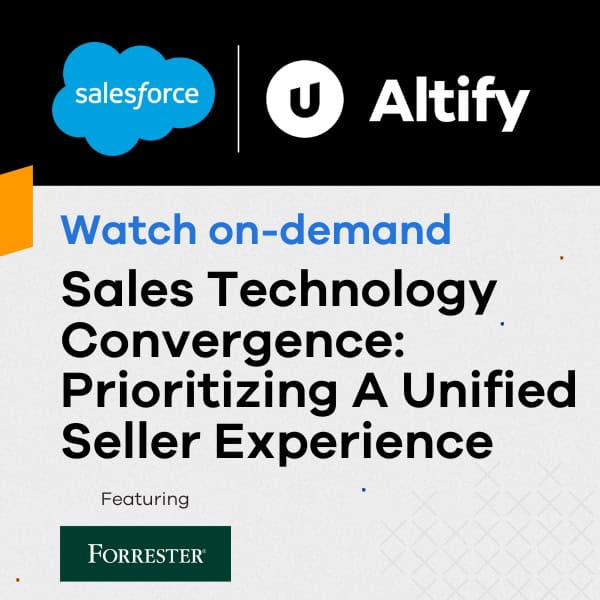Thinking about the impact on a customer: If you have read much of what I have written, you will undoubtedly have come across one of my favorite phrases:
The impact on a customer of a bad buying decision is typically greater than the impact on a salesperson of a lost deal.
I believe that to be a fundamental truth. If I buy the wrong CRM system, or customer service system, it can damage my business – in a bad way. The salesperson who lost that deal, will have lost the commission, but can move on to the next deal. But I’m stuck with the bad CRM or a customer service system that doesn’t fit my business.
The good news is that if a seller takes this truth to heart, she starts to think about the impact on the customer of her solution. That informs how she engages with the customer, where she can advise and add value, and how much resource to apply to win the deal and serve the customer. That’s a win/win. The customer gets a seller who has thought about the business. The seller, having thought about the impact on the customer, will have a more informed view, and is more likely to win.
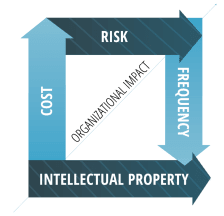 But as I said in a previous post, buyers buy different things, and how they buy and the opportunity for the salesperson to add value is often predicated on impact on the customer of the solution being purchased. A highly complex solution brings with a significant potential of gain for the buyer, but also brings more implementation risk. In this scenario, the buyer will value the contribution than a salesperson can bring, leveraging expertise from similar engagements with other customers.
But as I said in a previous post, buyers buy different things, and how they buy and the opportunity for the salesperson to add value is often predicated on impact on the customer of the solution being purchased. A highly complex solution brings with a significant potential of gain for the buyer, but also brings more implementation risk. In this scenario, the buyer will value the contribution than a salesperson can bring, leveraging expertise from similar engagements with other customers.
But how do you know what level of effort is required and appropriate?
To determine how best to engage with different types of customers, and to assess the right Strategy, Sales Execution behaviors, Sale Management practices, and Digital Sales Technology to apply in the sales engagement model, you have to consider the four levels of buyer / seller engagement. In my book Digital Sales Transformation in a Customer First World, I call these the four Customer Impact Levels – as seen from the customer’s perspective (the only perspective that really matters):
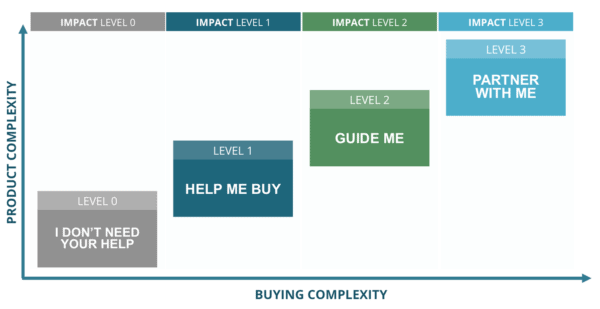
Customer Impact Level 0 / I DON’T NEED YOUR HELP: For sellers currently at this level, represented primarily by sales of commodity products, the salesperson is just an order taker and the future is bleak. This is where the Internet is more convenient and more efficient. In this stratum, the seller does not matter. The buyer just wants her company to be served. Characterized by frequent purchases, low price and commodity products – think copier paper or other office consumables as examples – the Internet is the seller who wins: more efficient, always available, low selling cost, and equivalent or better service. As Andy Hoar, principal analyst at Forrester, said at the 2015 Forrester Sales Enablement Forum, “So as technology gets better at explaining things, we don’t need humans to explain anymore.” (Note: As my audience is primarily B2B Enterprise sellers who add value to their customers, I don’t address Level 0 any further– it’s included here merely for completeness.)
Customer Impact Level 1 / HELP ME BUY: Where the product being purchased begins to adopt some complex characteristics, the buyer will usually have a buying process that, at an informal level, has more than a single buyer involved. The buyer will require detailed product knowledge from the seller and an ability to show the buyer how the product will meet her requirements and solve her business problem. Sales teams operating at this level will need to deploy a sales process, mapped to the customer’s buying process and implement a framework to achieve accelerated sales velocity, through consistent visibility and management of the process.
Customer Impact Level 2 / GUIDE ME: As the complexity of the product and the buying process grows, the impact on the customer increases correspondingly. The cost of sale also rises. Sellers need rigorous qualification skills to ensure that they are applying resources to sales opportunities that they can win and that, by winning those opportunities, they can deliver significant positive impact on the customers. Proficiency in relationship development is a basic requirement but, to be most effective at this level, sellers need to have significant business acumen. They need to understand the customer’s problems and aspirations and to project the impact their solution can have on the customer’s business. While sellers are working to win a specific opportunity, they also care about what happens after the sale and they are developing future relationships and potential future sales pipeline.
Customer Impact Level 3 / PARTNER WITH ME: At Level 3, the sales organization, and supporting functions in the company like Customer Success and Marketing, collaborate to take a holistic view of the customer’s company – not just the area of the business relating to a specific sales opportunity. Focus on creating, measuring and communicating value takes precedence in a ‘long game’ where the selling is a function of creating and delivering a common vision with the customer. Long term customer success, sustained relationships, and value creation are the tenets by which sales teams in Level 3 operate.
Discovering the Customer Impact Level
Customer impact generally maps to a combination of Product Complexity and Buying Complexity.
To determine the applicable Customer Impact Levels that will inform your customer engagements there are eight factors to consider – four from the buyer’s side, and four from the seller’s side.
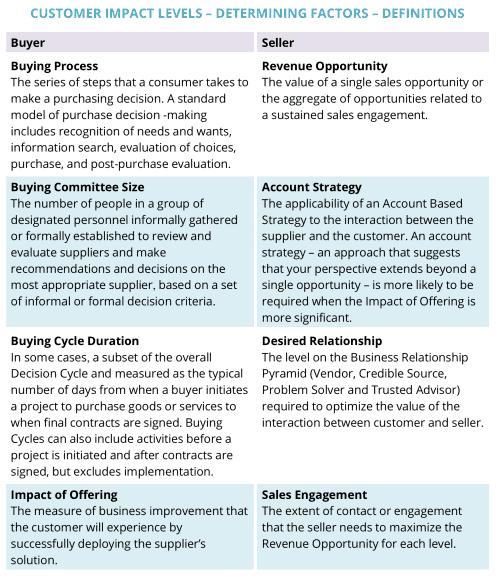
In the next graphic you can see sample values of each of the eight elements for each of the Customer Impact Levels. These are guideline values that I developed for one sales organization based on my experience of dealing with a very large number of similar sales organizations all over the world – but need to be customized to your own situation. It’s the relative values that matter – not the absolute values.
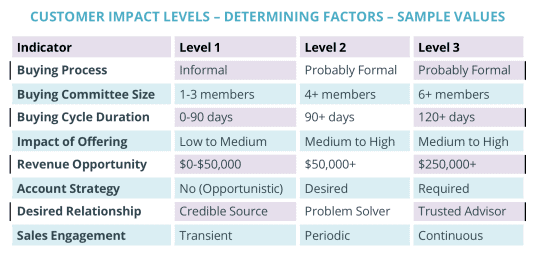
An opportunity may not display all the factors for a specific level at the values shown in the table so you may sometimes be a little unclear as to which impact level to choose. Sales is never completely black and white. Common sense should guide you as to which side of the dividing line your decision should fall. My advice is to err just a little on assuming greater impact than at first might be evident.
Once you have figured out the categories (or impact levels), you can model your customer engagement/sales strategy to maximize the value that you can deliver to the customer while optimizing the return on your sales investments.
These are the three high-level strategies that I recommend for each of the levels.
HELP ME BUY: Impact Customer Impact Level 1
STRATEGY – ALIGN WITH BUYING PROCESS TO ACCELERATE SALES: Design sales processes, mapped to the customer’s buying processes, and implement a framework for accelerated sales velocity, consistent visibility and management.
GUIDE ME: Impact Customer Impact Level 2
STRATEGY – BUILD RELATIONSHIPS THROUGH VALUE CREATION TO WIN: Enable sellers to qualify opportunities, build relationships, connect solutions to customer business problems, create value and position competitively. Implement a deal management framework with increased visibility and collaboration for higher win rate and larger deals.
PARTNER WITH ME: Customer Impact Level 3
STRATEGY – CREATE COMMON VISION TO GROW IN LARGE ACCOUNTS: Craft an integrated approach to elevate and expand relationships, understand the customer’s business, create, measure and communicate customer success. Implement an integrated framework for the account team to build pipeline and close revenue in existing accounts.
But, as Henry Ford said: Strategy without execution is hallucination. In future posts I will describe in detail the appropriate Sales Execution behaviors, Sale Management practices, and Digital Sales Technology to apply at each level.


